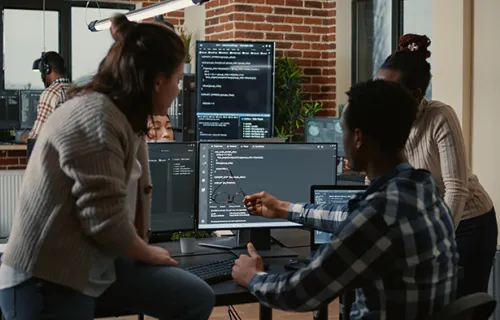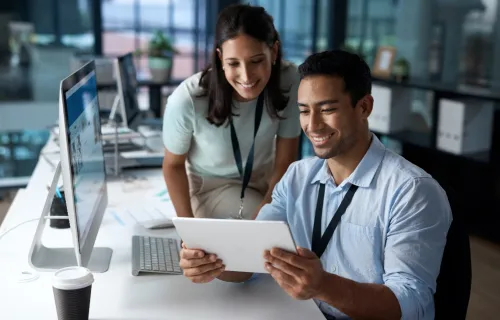In a way, you could say my journey to a new career at CGI took nearly 18 years. It started on a beautiful September Tuesday morning in Manhattan in 2001—a day in history that altered my path, as it also did for countless others.
At the time, I worked for the Federal Bureau of Investigation (FBI) New York Field Office. I’d been on a Joint Organized Crime Squad with the New York City Police Department since 1997 investigating the Genovese La Cosa Nostra family. While our ultimate target was the boss, Vincent “The Chin” Gigante, we were arresting his associates to get to the upper echelons.
On September 10, we arrested roughly half-a-dozen mid-tier players but one of our targets had already left for work when we arrived. However, he sensibly offered—through his lawyer—to turn himself in the next day.
So there we were on the morning of September 11 at the Manhattan FBI office at 26 Federal Plaza, just seven or eight blocks from the World Trade Center. I was upstairs processing my suspect—who had turned himself in as promised—when I heard the first loud boom. Lacking any exterior windows where I was, I thought it was the ever-present construction. When someone said a plane had hit the tower, I assumed it was an accident involving a small plane. About 20 minutes later, my partner Craig came in, his face ashen, and told me a large second plane hit the other tower. There was no doubt we were under attack.
When we got the order to evacuate moments later, my suspect, still in handcuffs, shouted, “Get me out of this building!” I couldn’t blame him. He promised to turn himself in again later, and I now had higher priorities. We took him to the lobby, uncuffed him, and gave him three bucks for the subway.
Outside, I retrieved my radio and raid jacket—the kind you see on TV with “FBI” across the back—and started running toward the World Trade Center. I was stepping over luggage, shoes and pieces of the plane as I got closer. As I and other agents gathered at the staging area, I heard a thunderous roar. To my horror, I saw the first tower was starting to collapse, the floors pancaking one onto the next.
Everyone scattered. I sprinted down the street and turned a corner, hoping that putting more buildings between the disaster and me would provide some protection. It did, but not enough to stop a movie-like cloud of smoke and ash from turning the corner and covering me in darkness.
The aftermath—seeing the need to share
In the weeks and months after that day, we worked on gathering evidence from Ground Zero and running down clues and leads. Eventually, though, I had to go back to organized crime and send The Chin to prison.
After that, I trained in explosive ordnance disposal (EOD) and became a bomb technician in 2005. My FBI career also included time on the New York Joint Terrorism Task Force and in Quantico, Virginia, running several of the FBI’s bomb tech programs. In 2010, I went to the Washington Field Office and traveled to Afghanistan on several occasions working extra-territorial investigations.
Over time, these assignments gave me firsthand experience with the incredibly fragmented and inefficient nature of law enforcement information gathering and sharing—an environment that had long been crippling our efforts to fight terrorist networks. The 9/11 Commission Report, issued in 2004, showed instances where an agency that uncovered useful information failed to share it with other agencies that could have acted on it.
After the Commission’s report, the situation began to improve. Intelligence agencies began sharing terrorism-related data and establishing fusion centers, one of the measures the 9/11 Commission recommended.
However, such progress has not yet expanded to other kinds of crime. The federal government has several agencies involved in enforcing federal law, and is often still stovepiped when they need to be open with each other.
The complications I’ve described apply to agencies working under the same government, ostensibly toward the same ends. However, sharing information internationally is also fraught with difficulty. I eventually went back to organized crime work with the FBI, this time in Budapest as an Assistant Legal Attaché embedded with the Hungarian National Police. At this point, given everything I had been exposed to and dealt with, I was banging my head on the table about the need for sharing information. (My UK-based colleague Nick Dale recently published a blog post on his view of the challenge. You can read it here.)
The 21st century criminal is leaving a trail in databases across the globe. When these stores of information remain static and unconnected, law enforcement personnel cannot develop a complete, real-time global picture of people they encounter. With puzzle pieces scattered among several agencies in different countries and no way to see the full picture, agents cannot identify the people intending catastrophic attacks in time to prevent them.
Staying in the fight
When I was ready to retire from law enforcement, I wanted to find a private-sector job—and a company—where I could still contribute to the mission. I found what I was looking for in CGI. I was impressed when I heard about the decade of success CGI has had in helping the United Kingdom develop a system to share law enforcement data among its many agencies. Further, I learned CGI’s current vision is to use this experience to assist U.S. law enforcement with sharing information, from the local to the global scale.
I retired from the government in December 2018 and started work with CGI Federal in January 2019. At CGI, I’m still working to address the data-sharing problems that have vexed me for more than two decades.
I recently shared a stage with Detective Superintendent Umberto Cuozzo, of the UK’s Durham Constabulary at the International Association of Chiefs of Police (IACP) Technology Conference to talk about local-to-global information sharing in combatting today’s criminal.
We agreed, law enforcement must lower the barriers and stigmas around sharing information both locally and internationally, and create a culture in which it is encouraged and rewarded.
Moreover, organizations need to make greater use of technology to make critical connections to disrupt criminals and prevent another catastrophic event.
The horrific attack 18 years ago changed the direction of my career and eventually led to me to CGI. I look forward to continuing to contribute to the mission.
You can also explore the value CGI brings to law enforcement agencies here.





